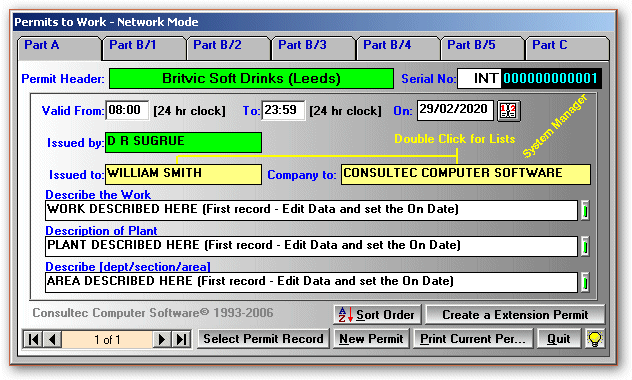

The aim of the permit to work system is to prevent injury to personnel and damage to plant by the acts or omissions of operators carrying out defined tasks on Company premises.

Permits to Work Part A Screen
Permit to Work A document which specifies the work to be done and the precautions to be taken before allowing work to start having defined safe procedures and considered all foreseeable hazards. It does not in itself make the job safe, but is dependent for its effectiveness on the persons concerned carrying out its requirements conscientiously. It is more stringent than a sites normal isolation procedure.
Circumstances in which a Permit to Work is to be used.
A Permit to Work is to be used with work involving any of the following:
1. Contractors - Any work involving contractors on site is to be covered by a Permit to Work. Contractors may or may not be familiar with the site and a permit to work provides a formal method of assessing any Health and Safety issues that the contractor and the site management may have to consider in relation to the task involved.
2. Hot Work - Hot work includes welding, flame cutting, brazing, grinding or any activity likely to produce heat or sparks. Permits are not required for safe areas designated for such work such as welding bays in maintenance workshops.
3. Confined spaces - A confined space is an area that is substantially enclosed. A permit to work is required in all circumstances involving this type of work. A safety person who is familiar with the plant, the activity and who has been briefed as to the action to take in the event of a problem arising is to be present at all times a person is within the confined space. The plant must be isolated of all the services to the enclosed space and consideration must be given to the activity being carried out. For instance hot work may require special extraction and or breathing apparatus. The temperature of and the time duration a person may be in the enclosed space should be considered and specified on the Permit to Work. If fumes are known to have existed they must be tested to be clear before entry is allowed.
4. Pressure Vessels - Any activity involving welding a pressure vessel should be covered by a permit to work and must be carried out only by a suitably coded welder. Maintenance activities involving work on pressure lines may need to be considered for permit to work where there is a hazard to personnel working which cannot be covered by a sites normal isolation practices or safe systems of work.
5. Work at Height - Any work involving access to roofs and or trenches must be covered by a permit to work. Work within the factory where there is a risk from falling objects that would endanger personnel or equipment should also be covered by a permit to work.
6. Chemical or Highly Flammable Areas - Work on chemical lines or tanks should be covered by a permit to work where that work is not a routine task covered by a safe system of work. Lines should be isolated from the supply, emptied and decontaminated as necessary. A permit is to be used where electrical equipment is to be used in chemical areas where highly flammable chemicals are present. For example - drills.
7. Electrical Systems - Where there is a hazard to personnel working which cannot be covered by a sites normal isolation practices or safe systems of work. All 11kV working must be covered by a Permit to Work.
8. Safety and Emergency Systems - Where there is a hazard to personnel working which cannot be covered by a sites normal isolation practices or safe systems of work.
9. Lone Working - Where a person is to work alone within an area of the site away from other personnel who can reasonably be communicated with then a permit to work is to be issued. The person and checkers are to be briefed on the procedure for lone working.
![]()
![]()
Health and Safety Risk - Assessments - Insurance Linked - Analyses Accidents - COSHH - Health and Safety Audit - Permit to Work